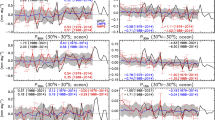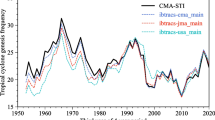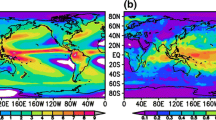Abstract
To understand how the tropopause annual evolution relates to the troposphere and lower stratosphere over southern South America, the study analyzes the joint behavior of single and double thermal tropopauses with the 500 and 100 hPa levels in the region. Radiosonde data spanning the period 1973–2014 were used. Geopotential height time series that were filtered known cycles were used as input for an unrotated S-mode principal components analysis. The first three leading modes of variability were analyzed. The first one has a strong semi-annual behavior, linked to wind cycles, with maximum activity in the center of the study region on the lee of the Andes. It appears to be linked to the vertical propagation of planetary and gravity waves. Semi-annual and terannual cycles dominate the second mode, the associated spatial patterns having strong resemblance with the occurrence of cold fronts. The annual time series for the third mode are coupled to a blocking index over the South Atlantic, and the associated spatial structures are also similar to blocking patterns. Results are in good agreement with observations, showing that the use of thermal tropopauses is a valid tool for studying different phenomena taking place in the region.











Similar content being viewed by others
References
Añel JA, Antuña JC, de la Torre L, Castanheira JM, Gimeno L (2008) Climatological features of global multiple tropopause events. J Geophys Res 113:D00B08. doi:10.1029/2007JD009697
Añel JA, de la Torre L, Gimeno L (2012) On the origin of the air between multiple tropopauses at midlatitudes. Sci World J. doi:10.1100/2012/191028
Appenzeller C, Davies HC (1992) Structure of stratospheric intrusions into the troposphere. Nature 358:570–572
Austin JF (1980) The blocking of middle latitude westerly winds by planetary waves. Quart J Roy Met Soc 106:327–350
Baldwin MP, Holton JR (1988) Climatology of the stratospheric polar vortex and planetary wave breaking. J Atmos Sci 45(7):1123–1142
Bischoff SA, Canziani PO, Yuchechen AE (2007) The tropopause at southern extratropical latitudes: Argentine operational rawinsonde climatology. Int J Climatol 27:189–207. doi:10.1002/joc.1385
Bluestein HB (1993) Fronts and jets. Synoptic-dynamic meteorology in midlatitudes. Volume II: Observations and theory of weather systems. Oxford, New York, pp 238–425
Bush ABG, Peltier WR (1994) Tropopause folds and synoptic-scale baroclinic wave life cycle. J Atmos Sci 51(12):1581–1604
Campetella CM, Possia NE (2007) Upper-level cut-off lows in southern South America. Meteorol Atmos Phys 96:181–191. doi:10.1007/s00703-006-0227-2
Canziani PO, Legnani WE (2003) Tropospheric-stratospheric coupling: extratropical synoptic systems in the lower stratosphere. Q J Roy Meteor Soc 129:2315–2329
Canziani PO, Compagnucci RH, Bischoff SA, Legnani WE (2002) A study of impacts of tropospheric synoptic processes on the genesis and evolution of extreme total ozone anomalies over southern South America. J Geophys Res D 24:4741. doi:10.1029/2001JD000965
Carlson TN (1998) Mid-latitude weather systems. American Meteorological Society, Boston
Castanheira JM, Gimeno L (2011) Association of double tropopause events with baroclinic waves. J Geophys Res 116:D19113. doi:10.1029/2011JD016163
Castanheira JM, Añel JA, Marques CAF, Antuña JC, Liberato MLR, de la Torre L, Gimeno L (2009) Increase of upper troposphere/lower stratosphere wave baroclinicity during the second half of the 20th century. Atmos Chem Phys 9:9143–9153. doi:10.5194/acp-9-9143-2009
Charney JG, Drazin PG (1961) Propagation of planetary-scale disturbances from the lower into the upper atmosphere. J Geophys Res 66(1):83–109
Chen X, Añel JA, Su Z, de la Torre L, Kelder H, van Peet J, Ma Y (2013) The deep atmospheric boundary layer and its significance to the stratosphere and troposphere exchange over the Tibetan Plateau. PLoS ONE. doi:10.1371/journal.pone.0056909
Compagnucci RH, Salles MA (1997) Surface pressure patterns during the year over southern South America. Int J Climatol 17:635–653
Compagnucci RH, Salles MA, Canziani PO (2001) The spatial and temporal behaviour of the lower stratospheric temperature over the Southern Hemisphere: the MSU view. Part I: data, methodology, and temporal behaviour. Int J Climatol 21:419–437. doi:10.1002/joc.606
Danielsen EF, Mohnen VA (1977) Project dustorm report: ozone transport, in situ measurements, and meterological analyses of tropopause folding. J Geophys Res 82(37):5867–5877
Davies HC, Schär CH, Wernli H (1991) The palette of fronts and cyclones within a baroclinic wave development. J Atmos Sci 48:1666–1689
Egger J (1998) Mountain torque and rossby wave radiation. J Atmos Sci 55:2937–2945
Fuenzalida HA, Sánchez R, Garreaud RD (2005) A climatology of cutoff lows in the Southern Hemisphere. J Geophys Res 110:D18101. doi:10.1029/2005JD005934
Goering MA, Gallus WA Jr, Olsen MA, Stanford JL (2001) Role of stratospheric air in a severe weather event: analysis of potential vorticity and total ozone. J Geophys Res 106(D11):11813–11823
Golub GH, Van Loan CF (1989) Matrix computations, 2nd edn. Johns Hopkins University Press, Baltimore
Grassi B, Redaell G, Canziani PO, Visconti G (2012) Effects of the PDO phase on the tropical belt width. J Climate 25:3282–3290. doi:10.1175/JCLI-D-11-00244.1
Griffiths MA, Thorpe AJ, Browining KA (2000) Convective destabilization by a tropopause fold diagnosed using potential-vorticity inversion. Quart J Roy Meteor Soc 126:125–144
Hartmann DL, Ghan SJ (1980) A statistical study of the dynamics of blocking. Mon Weather Rev 108:1144–1159
Hirschberg PA, Fritsch JM (1991a) Tropopause undulations and the development of extratropical cyclones. Part I: overview and observations from a cyclone event. Mon Weather Rev 119:496–517
Hirschberg PA, Fritsch JM (1991b) Tropopause undulations and the development of extratropical cyclones. Part II: diagnostic analysis and conceptual model. Mon Weather Rev 119:518–550
Hoskins BJ, Hodges KI (2005) A new perspective on southern hemisphere storm tracks. J Climate 18:4108–4129
Hoskins BJ, McIntyre ME, Robertson AW (1985) On the use and significance of isentropic potential vorticity maps. Q J Roy Meteor Soc 111:877–946
Inatsu M, Hoskins B (2004) The zonal asymmetry of the southern hemisphere winter storm track. J. Climate 17:4882–4892
Kållberg P, Berrisford P, Hoskins B, Simmons A, Uppala S, Lamy-Thépaut S, Hine R (2005) ERA-40 Atlas, ERA-40 Project report series No. 19. European Centre for Medium Range Weather Forecasts, Shinfield, Reading
Kalnay-Rivas E, Merkine L-O (1981) A simple mechanism for blocking. J Atmos Sci 38:2077–2091
Koch P, Wernli H, Davies HC (2006) An event-based jet-stream climatology and typology. Int J Climatol 26:283–301. doi:10.1002/joc.1255
Kutzbach JE (1967) Empirical eigenvectors of sea-level pressure, surface temperature and precipitation complexes over North America. J Appl Meteorol 6:791–802
Langford AO, Proffitt MH, VanZandt TE, Lamarque JF (1996) Modulation of tropospheric ozone by a propagating gravity wave. J Geophys Res 101(D21):26605–26613
Lejenäs H (1984) Characteristics of Southern Hemisphere blocking as determined from a time series of observational data. Q J Roy Met Soc 110:967–979
Marengo J, Cornejo A, Satyamurty P, Nobre C, Sea W (1997) Cold surges in tropical and extratropical South America: the strong event in June 1994. Mon Weather Rev 125:2759–2786
Martius O, Schwierz C, Davies HC (2010) Tropopause-level waveguides. J Atmos Sci 67:866–879
Mastrantonio G, Einaudi F, Fua D, Lalas DP (1976) Generation of gravity waves by jet streams in the atmosphere. J Atmos Sci 33:1730–1738
McHall YL (1992) Nonlinear planetary wave instability and blocking. Adv Atmos Sci 9(2):173–190
McIntyre ME, Palmer TN (1983) Breaking planetary waves in the stratosphere. Nature 305:593–600
McIntyre ME, Palmer TN (1984) The ‘surf zone’ in the stratosphere. J Atmos Terr Phys 46(9):825–849
Mehta SK, Ratnam MV, Krishna Murthy BV (2011) Multiple tropopause in the tropics: a cold point approach. J Geophys Res 116:D20105. doi:10.1029/2011JD016637
Moore GWK, Peltier WR (1987) Cyclogenesis in frontal zones. J Atmos Sci 44(2):384–409
Morgan MC, Nielsen-Gammon JW (1998) Using tropopause maps to diagnose midlatitude weather systems. Mon Weather Rev 126:2555–2579
Nakamura N (2007) Extratropical stratosphere-troposphere mass exchange associated with isentropic mixing: a 1992–2005 climatology derived from advection-diffusion calculations. J Geophys Res 112:D24303. doi:10.1029/2006JD008382
Nappo CJ (2002) Terrain-generated gravity waves. An introduction to atmospheric gravity waves. Academic Press, San Diego, pp 47–84
Nathan TR, Hodyss D (2010) Tropopshere-stratosphere communication through local vertical waveguides. Q J Roy Meteor Soc 136:12–19
Nielsen-Gammon JW (2001) A visualization of the global dynamic tropopause. B Am Meteorol Soc 82(6):1151–1167
Palmén E, Newton CW (1969) Atmospheric circulation systems. Academic Press, London
Pan LL, Randel WJ, Gille JC, Hall WD, Nardi B, Massie S, Yudin V, Khosravi R, Konopka P, Tarasick D (2009) Tropospheric intrusions associated with the secondary tropopause. J Geophys Res 114:D10302. doi:10.1029/2008JD011374
Pavelin EJ, Whiteway A, Vaughan G (2001) Observation of gravity wave generation and breaking in the lowermost stratosphere. J Geophys Res 106(D6):5173–5179
Peevey TR, Gille JC, Randall CE, Kunz A (2012) Investigation of double tropopause spatial and temporal global variability utilizing High Resolution Dynamics Limb Sounder temperature observations. J Geophys Res 117:D01105. doi:10.1029/2011JD016443
Plougonven R, Snyder C (2007) Inertia–gravity waves spontaneously generated by jets and fronts. Part I: different baroclinic life cycles. J Atmos Sci 64:2502–2520
Postel GA, Hitchman MH (1999) A Climatology of Rossby Wave Breaking along the Subtropical Tropopause. J Atmos Sci 56:359–373
Postel GA, Hitchman MH (2001) A case study of rossby wave breaking along the subtropical tropopause. Mon Weather Rev 129:2555–2569
Price JD, Vaughan G (1993) The potential for stratosphere-tropopshere exchange in cut-off low systems. Q J Roy Meteorol Soc 119:343–365
Randel WJ, Seidel DJ, Pan LL (2007) Observational characteristics of double tropopause. J Geophys Res 112:D07309. doi:10.2019/2006JD007904
Reed RJ (1955) A study of a characteristic type of upper-level frontogenesis. J Meteorol 12:226–237
Reiter ER (1975) Stratospheric-tropospheric exchange processes. Rev Geophys Space Phys 13(4):459–474
Richman MB, Gong X (1999) Relationships between the definition of the hyperplane width to the fidelity of principal component loading patterns. J Climate 12:1557–1576
Salles MA, Canziani PO, Compagnucci RH (2001) The spatial and temporal behaviour of the lower stratospheric temperature over the Southern Hemisphere: the MSU view. Part II: spatial behaviour. Int J Climatol 21:439–454. doi:10.1002/joc.607
Santer BD, Sausen R, Wigley TML, Boyle JS, AchutaRao K, Doutriaux C, Hansen JE, Meehl GA, Roeckner E, Ruedy R, Schmidt G, Taylor KE (2003) Behavior of tropopause height and atmospheric temperature in models, reanalyses, and observations: decadal changes. J Geophys Res 108(D1):4002. doi:10.1029/2002JD002258
Seidel DJ, Randel WJ (2006) Variability and trends in the global tropopause estimated from radiosonde data. J Geophys Res 111:D21101. doi:10.1029/2006JD007363
Seidel DJ, Randel WJ (2007) Recent widening of the tropical belt: evidence from tropopause observations. J Geophys Res 112:D20113. doi:10.1029/2007JD008861
Seluchi ME, Garreaud RD, Norte FA, Saulo AC (2006) Influence of the subtropical Andes on baroclinic disturbances: a cold front case study. Mon Weather Rev 134:3317–3335
Shapiro MA, Hampel T, Krueger AJ (1987) The Arctic tropopause fold. Mon Weather Rev 115:444–454
Škerlak B, Sprenger M, Wernli H (2014) A global climatology of stratosphere–troposphere exchange using the ERA-interim data set from 1979 to 2011. Atmos Chem Phys. doi:10.5194/acp-14-913-2014
Smith RB, Woods BK, Jensen J, Cooper WA, Doyle JD, Jiang Q, Grubišič V (2008) Mountain waves entering the stratosphere. J Atmos Sci 65:2543–2562
Spaete PD, Johnson R, Schaack TK (1994) Stratospheric–tropospheric mass exchange during the presidents’ day storm. Mon Weather Rev 122:424–439
Staley DO, Gall RL (1977) On the wavelength of maximum baroclinic instability. J Atmos Sci 34(11):1679–1688
Steinbrecht W, Claude H, Köhler U, Hoinka KP (1998) Correlations between tropopause height and total ozone. J Geophys Res 103(D15):19183–19192
Stohl A, Bonasoni P, Cristofanelli P, Collins W, Feichter J, Frank A, Forster C, Gerasopoulos E, Gäggeler H, James P, Kentarchos T, Krompt-Kolb H, Krüger B, Land C, Meloen J, Papayannis A, Priller A, Seibert P, Sprenger M, Roelofs JG, Scheel HE, Schnabel C, Siegmund P, Tobler L, Trickl T, Wernli H, Wirth V, Zanis P, Zerefos C (2003) Stratosphere–troposphere exchange: a review, and what we have learned from STACCATO. J Geophys Res 108(D12):8516. doi:10.1029/2002JD002490
Tuck AF, Browell EV, Danielsen EF, Holton JR, Hoskins BJ, Johnson, Kley D, Krueger AJ, Megie G, Newell RE, Vaughan G (1985) World Meteorological Organization, 1986: Strat-trop exchange. Atmospheric ozone 1985. Global ozone research and monitoring report, Report 16. World Meteorological Organization, Geneva, pp 151–240
Uccellini LW, Keyser D, Brill KF, Walsh CH (1985) The President’s Day Cyclone of 18–19 February 1979: influence of trough amplification and associated tropopause folding on rapid cyclogenesis. Mon Weather Rev 113:962–988
Vallis GK (2006) Planetary waves and the stratosphere. Atmospheric and ocean fluid dynamics. Cambridge University Press, Boca Raton, pp 541–580
Wallis TWR (1998) A subset of core stations from the comprehensive aerological reference dataset (CARDS). J Climate 11:272–282
Wandishin MS, Nielsen-Gammon JW, Keyser D (2000) A potential vorticity diagnostic approach to upper-level frontogenesis within a developing baroclinic wave. J Atmos Sci 57:3918–3938
Wang S, Polvani L (2011) Double tropopause formation in idealized baroclinic life cycles: the key role of an initial tropopause inversion layer. J Geophys Res 116:D05108. doi:10.1029/2010JD015118
Wilks DS (2006) Empirical distributions and exploratory data analysis. In: Dmowska R, Hartmann D, Rossby HT (eds) International geophysics series, statistical methods in the atmospheric sciences, 2nd edn. Academic Press, London, pp 23–70
WMO (1957) Meteorology: a three-dimensional science: second session of the commission for aerology. WMO Bull IV 4:134–138
WMO (1992) International meteorological vocabulary, WMO—No 182, 2nd edn. Secretariat of the World Meteorological Organization, Geneva
Yuchechen AE (2009) La tropopausa térmica en el sur de Sudamérica: climatología, variabilidad, y relaciones con la troposfera media y la baja estratósfera (The termal tropopause in southern South America: climatology, variability, and relationships with the middle troposphere and the lower stratosphere). Ph.D. dissertation, Universidad de Buenos Aires
Yuchechen AE, Bischoff SA, Canziani PO (2010) Latitudinal height couplings between single tropopause and 500 and 100 hPa within the Southern Hemisphere. Int J Climatol 30:492–508. doi:10.1002/joc.1914
Acknowledgments
The authors wish to thank to an anonymous reviewer for their helpful comments. This research was funded by Agencia Nacional de Promoción Científica y Tecnológica (ANPCyT) PICT 2007 1888, PICT 2012 2927 and CONICET PIP 2012/4 0075 grants. In loving memory of Susana Bischoff.
Author information
Authors and Affiliations
Corresponding author
Additional information
Responsible Editor: L. Gimeno.
S. A. Bischoff: Deceased.
Rights and permissions
About this article
Cite this article
Yuchechen, A.E., Canziani, P.O. & Bischoff, S.A. Stratosphere/troposphere joint variability in southern South America as estimated from a principal components analysis. Meteorol Atmos Phys 129, 247–271 (2017). https://doi.org/10.1007/s00703-016-0454-0
Received:
Accepted:
Published:
Issue Date:
DOI: https://doi.org/10.1007/s00703-016-0454-0




